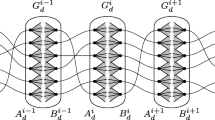Abstract
Previous researchers have designed shared control schemes with a view to minimising the likelihood that participants will conspire to perform an unauthorised act. But, human nature being what it is, systems inevitably fail; so shared control schemes should also be designed so that the police can identify conspirators after the fact. This requirement leads us to search for schemes with sparse access structures. We show how this can be done using ideas from coding theory. In particular, secret sharing schemes based on geometric codes whose dual [n,k,d] codes have d and n as their only nonzero weights are suitable. We determine their access structures and analyse their properties. We have found almost all of them, and established some relations among codes, designs and secret-sharing schemes.
Similar content being viewed by others
References
R.J. Anderson, Why Cryptosystems Fail, Communications of the ACMVol 37, No.11 (1994) pp. 32-40.
E.F. Assmus, Jr. and J.D. Key, Designs and Their Codes, Cambridge University Press, Cambridge (1992).
G.R. Blakley, Safeguarding cryptographic keys, Proceedings of NCC AFIPS (1979) pp. 313-317.
A. Bonisoli, Every equidistance linear code is a sequence of dual Hamming codes, Ars CombinatoriaVol. 18 (1983) pp. 181-186.
R. Calderbank, W.M. Kantor, The geometry of two-weight codes, Bulletin of the London Mathematical Society, Vol. 18 (1986) pp. 97-122.
Y. Desmedt, Y. Frankel, Threshold cryptosystems, Advances in Cryptology: Proceedings of Crypto 89, Lecture Notes in Computer Science, Springer-Verlag, New York, 435 (1990) pp. 307-315.
E.D. Karnin, J.W. Green, M. Hellman, On secret sharing systems, IEEE Transactions on Information Theory, Vol. IT-29 (1983) pp. 644-654.
F.J. MacWilliams, N.J.A. Sloane, The Theory of Error-Correcting CodesNorth-Holland, Amsterdam (1978).
J.L. Massey, Minimal codewords and secret sharing, Proceedings of the 6th Joint Swedish-RussianWorkshop on Information Theory, Mölle, Sweden, August 22-27, 1993 pp. 276-279.
J.L. Massey, Some applications of coding theory in cryptography, Codes and Ciphers: Cryptography and Coding IV(Ed. P.G. Farrell), IMA, England (1995) pp. 33-47.
R.J. McEliece, D.V. Sarwate, On sharing secrets and Reed-Solomon codes, Communications of the ACMVol. 24 (1981) pp. 583-584.
M.K. Reiter, M.K. Franklin, J.B. Lacy, R.A. Wright, The Omega Key Management Service, Proceedings of 3rd ACM Conference on Computer and Communications Security, ACM Press (1997) pp. 38-47.
A. Shamir, How to share a secret, Communications of the ACM, Vol. 22 (1979) pp. 612-613.
VISA Security Module Operations Manual, VISA, 1986
Author information
Authors and Affiliations
Rights and permissions
About this article
Cite this article
Anderson, R., Ding, C., Helleseth, T. et al. How to Build Robust Shared Control Systems. Designs, Codes and Cryptography 15, 111–124 (1998). https://doi.org/10.1023/A:1026421315292
Issue Date:
DOI: https://doi.org/10.1023/A:1026421315292




